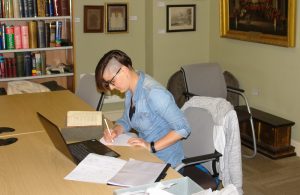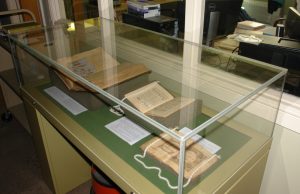Working with the Ottoman Manuscripts
We are grateful to Yaren Sabah Sahili for this week’s blog post. Yaren is currently studying in for her Masters in Art History and Museum Curating at the University of Sussex. As part of her course she undertook a work placement with the Royal Asiatic Society. She is from Turkey and so she has been working on our Ottoman manuscripts. Her post explains more…
Placement at the RAS
As part of the MA in Art History and Museum Curating at the University of Sussex, students are required to undertake a four-week work placement. This provides an opportunity to use your curatorial skills as well as have good practice with real objects. As a Turkish student who studied Islamic/Turkish art for a long time, it’s an amazing opportunity to work at The Royal Asiatic Society. I’m about to finish my last week’s placement under the supervision of archivist Nancy and librarian Ed, and I already have learnt important skills since my first week.
Working at the RAS
Before describing my studies so far, I would like to confess something. Honestly, when I received the name of my placement institution from my university supervisor, I did some short research on the internet about the RAS, and mostly I saw that they focus on Far East countries’ art. I stopped for a minute and I thought that “I am not from these countries, Turkey is not even close, and I have no idea about their culture or art. How will I do it?” In the beginning, the placement did not make sense, however as soon as I met with my supervisors and they explained me the society, their archive and what I should do, then something started to change in my mind. Since I have started to work there, in time, many things changed, and now I’m so happy to be placed at the institution,
What do I do at the RAS? The RAS has a small Ottoman manuscript archive of around 50 codex manuscripts. As a Turkish student, it was a privilege to study on these manuscripts. I am saying as a Turkish student because the Ottoman Empire was a big Empire centred on Turkey. The current Republic is an heir of the Ottoman Empire. During my undergraduate studies, I was taught Ottoman Language for one year. However, never I have found an opportunity to use the skills. Because at my first master’s in my country, I studied on Byzantine manuscripts, and now I do Museum Curating MA. It’s not my first experience with the manuscripts, but it’s a good experience to study a historic language that I learned. For these reasons, engaging with Ottoman handwritten manuscripts closely is an important duty for me.

What have I done with these manuscripts? Of course, when I started, I had no idea how I need to handle such historical materials. Ed kindly showed it to me, and he described other materials to use when I handle a book. Once we found a few objects in the same box which were numbered as usual but uncatalogued. They were folded from the middle which can cause damage to text. Nancy showed me how I should design protection for the materials. Most of the manuscripts were added on the online catalogue at Fihrist with short titles and author’s name. However, we could not find the same catalogue entries on the RAS online catalogue. For these reasons, I started to read these manuscripts and match them with Fihrist catalogue, then I did catalogue entries for the RAS online catalogue. Moreover, I found more details in the few manuscripts and I did wider catalogue descriptions than Fihrist. Today if you go to the RAS catalogue, you can find the whole Ottoman manuscript archive online with many new pieces of information and details. Most of the collection remained from the 18th or 19th century, and they give important information about the Ottoman Empire’s history, society, relations with other countries and the Religion of Islam. I tried to give more details as much as I can about the collection in the online catalogue. I believe that it’s a good opportunity for a researcher to know where they can find a source about the society, history, religion etc. of the Ottoman Empire.
Before Finishing
I have gained many new skills thanks to the RAS and every day I learn new skills from Nancy and Ed. They help me not only to do the placement in a better way but also with my personal studies. As an Art History and Museum Curating MA student, you always need good and wide networks at museums to keep up with news, skills and opportunities. However, for an individual student, it can be hard to gain these if you don’t have a guide who will illuminate you. Hence, I would say that I‘m lucky to have the RAS as my placement because all the institution’s members are very kind to help me and be my guide for my personal studies. Now before finishing my placement, we have been thinking about a display from the collection. Most of the pieces of the archive consist of official records of the Ottoman Empire. However, there are a few examples have different approaches, and I believe that they need to be seen by others. A small size Qur’an, one illuminated manuscripts, and calligraphic manuscripts are going to be my first materials for my first display. By the end of my placement, I’m sure that I will have gained many different skills such as, doing a small exhibition, reading the historic text, handling objects, the ways of conservation, doing catalogue entries and much more.

We are very grateful to Yaren for making our Ottoman manuscripts more accessible and for the time she has taken in curating the display and writing this blog. The final thing she will undertake is to write about the manuscripts for our website. This will give a permanent highlight to this collection. We thank Yaren and wish her the very best for her future career.
In other news, tonight is the lecture by RAS Librarian, Edward Weech. We will highlight that in next week’s blog. And on Wednesday 11 June, the RAS joins with the Art Palace of Georgia for the book launch of “The Living Alphabet”, a beautiful facsimile of a unique Georgian manuscript, Sulkhan- Saba Orbeliani’s Georgian dictionary, which was rewritten at the end of 18th Century by a famous calligrapher Petre Laradze. To register for this event please follow the link.
